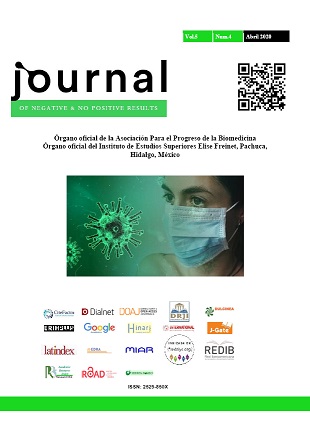Third stage of labor directed with intraumbilical oxytocin
DOI:
https://doi.org/10.19230/jonnpr.3283Keywords:
Third stage of labor directed, intraumbilical, oxytocinAbstract
Objective: To demonstrate effectiveness of third stage of labor directed with intraumbilical oxytocin in the delivery room at Hospital "Dr. José María Carabaño Tosta", in Maracay, Aragua, Venezuela.
Type of study: Cross-sectional, carried out between February-August 2019.
Materials and methods: 50 patients managed with third stage of labor led with 10 IU oxytocin through the umbilical vein (exposed group) and 50 patients managed with spontaneous third stage of labor (control group). We compared time of birth, blood loss and clinical outcome.
Results: Exposed group: 3.52 minutes average delivery time, average volume of the bleeding 112.8 ml and mean hemoglobin hematocrit value pre and post-delivery 11,01 gr/dl-34,3% and 10.7 gr/dl-32,4% respectively. Control group: 13,02 minutes average delivery time, average volume of bleeding 232,7 ml and mean hemoglobin hematocrit value pre and post-partum 11.3 gr/dl-34,9% and 10.1 gr/dl-31,2% respectively. The exposed group did not present any complication, while 4% of the control group presented uterine hypotonia and post-partum hemorrhage.
Conclusion: In the experimental group, the birth was significantly quicker and the lost blood were significantly lower (p: 0.000). We concluded that placenta with oxytocin via umbilical is more effective compared with spontaneous labor. There is no reason not to perform third stage of labor oxitocine in order to decrease obstetric hemorrhage risk and further complications.
Downloads
References
Sanabria DS, Olivar FA, Peña CI, Blanco GM. Misoprostol en la conducta activa en el tercer período del parto: dosis mínima efectiva. ROGV. 2015; 75(3): p. 155-163.
Organizaciónn Mundial de la Salud. Recomendaciones de la OMS para la prevención y el tratamiento de la hemorragia postparto. 2012.
Gómez RD. http://repositorio.ual.edu.pe/. [Online]. Lima; 2016 [cited 2019 sept 24. Available from: http://repositorio.ual.edu.pe/handle/UAL/31.
Lojano M. Estudio clínico aleatorizado de la eficacia de la oxitocina vía cordón umbilical en el manejo activo del tercer período del parto, Hospital Vicente Corral Moscoso. [Online].; 2014 [cited 2019 Sept 24. Available from: http://dspace.ucuenca.edu.ec/handle/123456789/5247.
Campero-Maneiro U, Santos-Bolívar J, Aragón J, Torres-Cepeda D, et al. Inyección de oxitocina en la vena umbilical en el manejo activo del alumbramiento. MedULA. 2013; 22(1): p. 10-14.
Gutarra-Vílchez R, Campos T, Samalvides F. Rev. peru. ginecol. obstet. 2012; 58(4): p. 285-290.
Maciel MM, López F, Ramos AG, López CA. Oxitocina transvena umbilical para acortar el tercer periodo de trabajo de parto. Ginecol Obstet Mex. 2006; 74(2): p. 89-94.
Hauksson A. Oxytocin injection into the umbilical vein in women with retained placenta: A questionable method. Am J Obstet Gynecol. 1986 Nov; 155(5): p. 1140.
Published
Issue
Section
License
All accepted originals remain the property of JONNPR. In the event of publication, the authors exclusively transfer their rights of reproduction, distribution, translation and public communication (by any sound, audiovisual or electronic medium or format) of their work. To do so, the authors shall sign a letter transferring these rights when sending the paper via the online manuscript management system.
The articles published in the journal are freely used under the terms of the Creative Commons BY NC SA license, therefore.
You are free to:
Share — copy and redistribute the material in any medium or format
Adapt — remix, transform, and build upon the material
The licensor cannot revoke these freedoms as long as you follow the license terms.
Under the following terms:
Attribution — You must give appropriate credit, provide a link to the license, and indicate if changes were made. You may do so in any reasonable manner, but not in any way that suggests the licensor endorses you or your use.
NonCommercial — You may not use the material for commercial purposes.
ShareAlike — If you remix, transform, or build upon the material, you must distribute your contributions under the same license as the original.
No additional restrictions — You may not apply legal terms or technological measures that legally restrict others from doing anything the license permits.

This work is licensed under a Creative Commons Attribution-NonCommercial-ShareAlike 4.0 International License

























